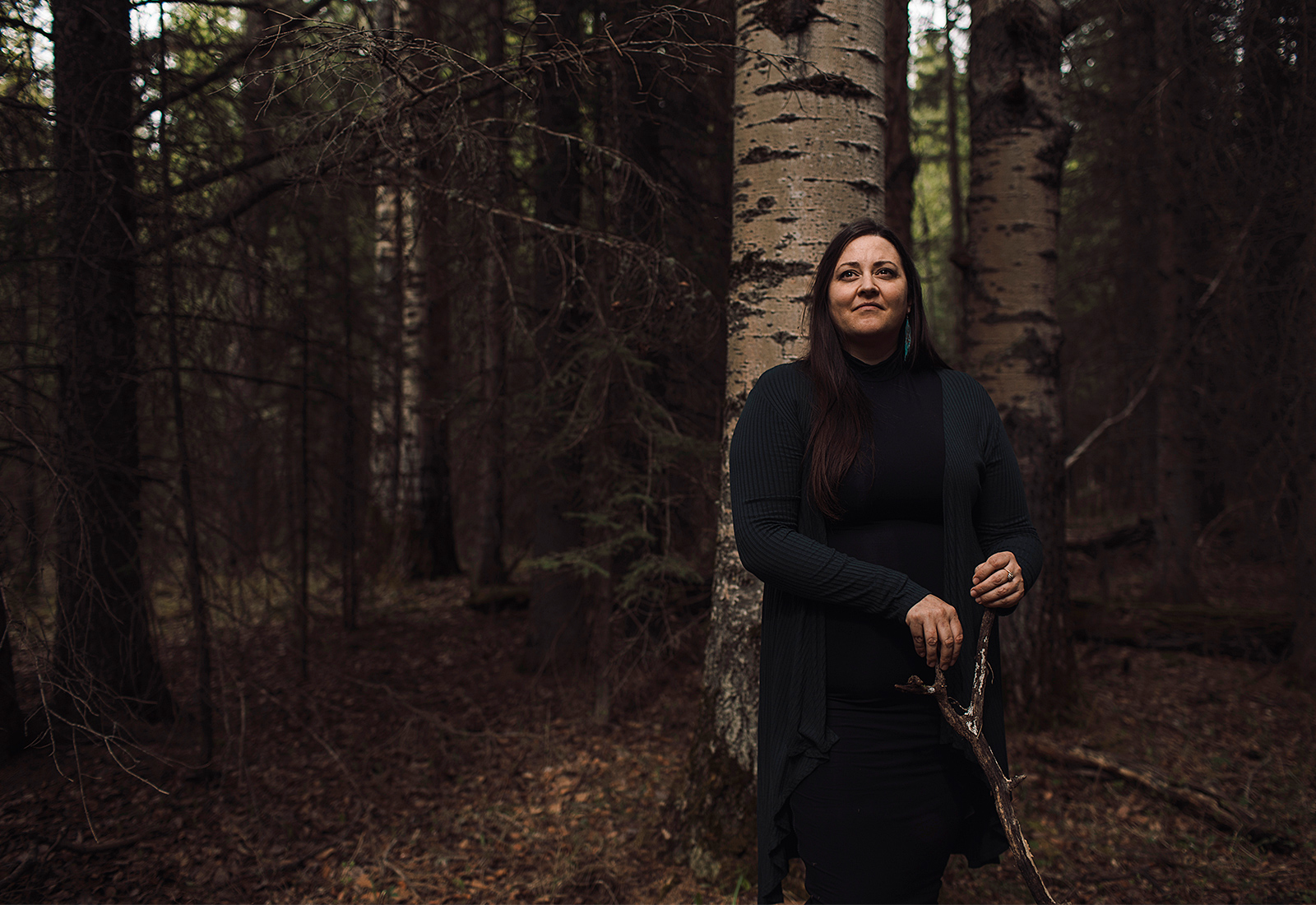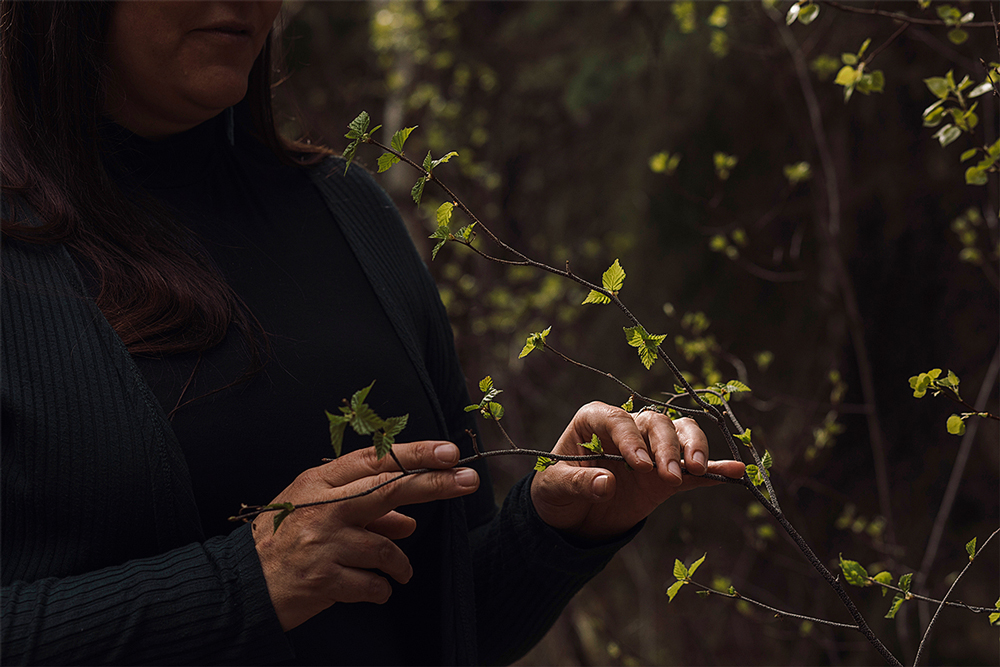Growing up in Whitecourt, Alta., Amy Cardinal Christianson, ’03 BSc(Hons), ’11 PhD, was no stranger to wildfires. The familiar grey-green haze exhaled by distant blazes was common in the summer months, and many of her extended family were involved in fire management. In 1998, her community was threatened by the Virginia Hills fires, which tore through more than 150,000 hectares of nearby forests and forced 2,000 people to evacuate from neighbouring towns.
In her experience, fire was something to be feared.
It wasn’t until her master’s and PhD research sparked her interest in how Indigenous communities respond to hazards such as wildfires that she learned that fire is much more than a destructive force. Fire has the power to renew the land, connect people with their environments and keep culture alive.
As a Métis woman from the Cardinal and Laboucane families in Owl River and Fort McMurray, and now a fire social scientist with the Canadian Forest Service, Cardinal Christianson researches communities impacted by wildfire evacuations and supports Indigenous Peoples in their fire stewardship practices like cultural burning. Here’s what she’s learned about the many faces of fire.
1: Not all fire is created equal
From the pilot light on your hot water tank to a summer bonfire to the flames burning up hydrogen gas in volcanic vents, fire is many different things. Some flames are easily controlled; others are not.
In 2021 so far, more than 5,800 wildfires have destroyed nearly 4,000,000 hectares of land in Canada, tearing through towns and forcing communities to evacuate. “There is good reason to be scared of fire,” Cardinal Christianson says.
But not all fire is bad. Many Indigenous communities use fire as a tool to maintain a relationship with the natural world, she says. They do this through cultural burning — a practice in which Indigenous fire knowledge keepers light small, slow-burning fires in grasslands in order to promote vegetative growth and encourage animals to inhabit the area.
Cultural burning also helps to create breaks in the landscape which prevent forest fires from spreading. Where wildfires destroy plant life, annihilate animal habitats and devastate communities, controlled cultural burns are one element in maintaining a natural and cultural ecosystem.
“A lot of times, in a Western wildfire management system, we see fire as more of a threat,” she says. But, she adds, Indigenous Peoples see fire in a more holistic way. “It’s part of the environment, and if used properly it can be really good.”
2: Cultural burning renews the land
For thousands of years, many Indigenous communities have used fire to renew the land, stimulating the growth of medicinal plants, creating grazing lands for animals and managing pests. The specific goals of the burn will vary from one community to the next, but there’s a common understanding about fire: “It’s a medicine for the land,” she says.
Some communities burn meadows to kill saplings that are encroaching on the grasslands. Others may burn to promote the growth of medicinal and food plants, to send smoke up into the tree canopies to control pests or to cool the streams with smoke inversion, thereby improving fisheries.
Fire can also be used to blacken the ground, which brings wildlife to the area. “The black absorbs the heat from the sun, and it melts the frost out of the ground faster. You get earlier grass growth, which gives the moose and deer something to eat sooner.” For communities that rely on deer or moose hunting, the burns help preserve their way of life.
Just like water and sunlight, fire is an essential ingredient in the health of many ecosystems.
3: Fire fuels culture
By the turn of the 21st century, most provinces in Canada had banned unregulated burning. This made cultural burning for Indigenous Nations illegal and amounted to what Cardinal Christianson calls “cultural severance.”
Because fire is so integral in promoting plant and animal species that Indigenous communities rely on, fire prohibition leaves black marks on many aspects of life. Without fire to coax the strong, straight shoots of hazel, no baskets could be woven for newborn babies. Without the black soot to capture heat, the growing season became shorter. Without fire to promote fresh grass, the animals moved elsewhere.
“For Indigenous Peoples, if you’re not able to promote that cultural resource or cultural keystone species, and you’re not able to use it for your culture, that aspect of your culture dies,” she says. “Without culture, you can’t really be a nation.”
Today, many First Nations in Canada can techincally burn on reserve land, however some communities are still fighting to be able to burn on surrounding crown, or unceded, lands. For them, burning is inextricably linked with their way of life.
4: Prescribed burns are not cultural burns
Fire agencies across Canada regularly partake in what might seem like a similar practice to cultural burning. Prescribed, or controlled burns, are fires that are intentionally lit in order to reduce the risk of major wildfires, to manage landscapes or to restore natural areas. But Cardinal Christianson points out that while they have some similarities, they’re vastly different practices on the ground.
A single prescribed fire can cover hundreds to thousands of hectares of land and very quickly, too. “Agency burning is usually pretty fast and hot,” she says, adding that agencies will sometimes use the wind as a tool to move the flames higher and faster. “They call it production burning.”
Cultural burns, on the other hand, are generally small, highly localized fires that burn “low and slow.” They’re managed by Indigenous Peoples from that area who have a close relationship with the land. Cardinal Christianson says cultural burns are different from community to community, but many use a low flame height and very low fire intensity. “Especially if you’re doing a burn for berries, you don’t want to disturb the roots of the plant. You just kind of want to clean up that top layer.”
But the biggest difference, she says, is the goal. “With a cultural burn, the main objective is always a cultural one.” As the flames burn away dead grass and brush, they rekindle a longstanding relationship with the land. Fire is a tool and a medicine that allows Indigenous communities to carry on their ways of life.
5: Not all fire is ours to light
There’s been a surge in interest in Indigenous fire stewardship in the past year alone. Some see traditional fire knowledge as the answer to reducing wildfire severity and think that cultural burning practices should be adopted into western fire management systems. But Cardinal Christianson thinks agencies that adopt these fire practices risk missing the point.
“I'm personally really worried about the cultural appropriation of fire knowledge into agencies,” she says. “The second you lose the cultural ties to fire, it kind of takes away the whole purpose for burning.” Plus, she says cultural burning hinges on a relationship with the land that can’t be easily translated into an institutional procedure.
“One Elder would tell me how he would go out of his house and look at the spruce trees to see how plump the spruce needles were. From there, he could tell how dry it was and whether it would be safe for him to burn. I mean, how can you write that into a burn prescription?”
Despite public enthusiasm for Indigenous fire knowledge, Cardinal Christianson says it’s still western agencies that hold the matches. As a Métis woman and a fire researcher with the government, she sees both sides. “I understand it from a health and safety perspective, [but] it removes the most important part of cultural burning, which is listening to the land and knowing when it needs to be burned.”
Many Indigenous nations have to seek approval to burn in certain areas, but she’d like to see the authority to burn transferred back to the communities. “It’s one of those things where it’s one step forward and three steps back,” she says, “but that would be my ultimate hope.”


We at New Trail welcome your comments. Robust debate and criticism are encouraged, provided it is respectful. We reserve the right to reject comments, images or links that attack ethnicity, nationality, religion, gender or sexual orientation; that include offensive language, threats, spam; are fraudulent or defamatory; infringe on copyright or trademarks; and that just generally aren’t very nice. Discussion is monitored and violation of these guidelines will result in comments being disabled.